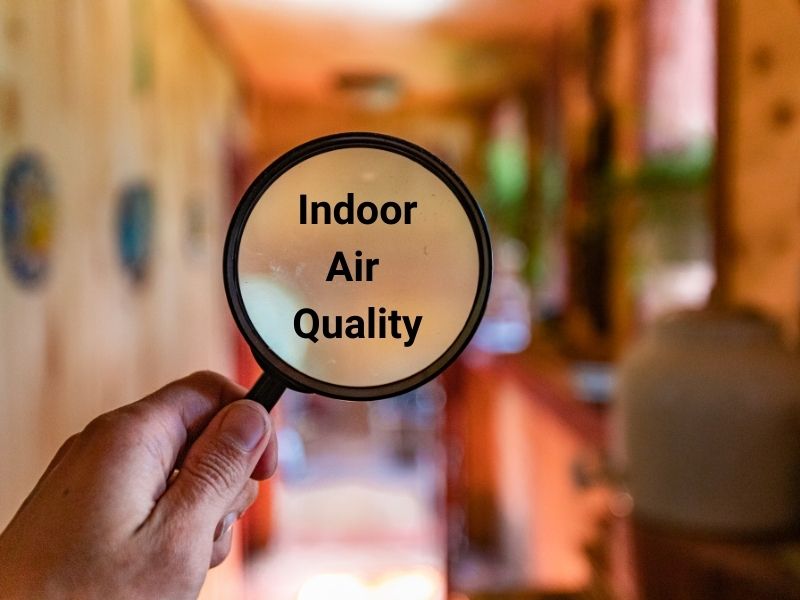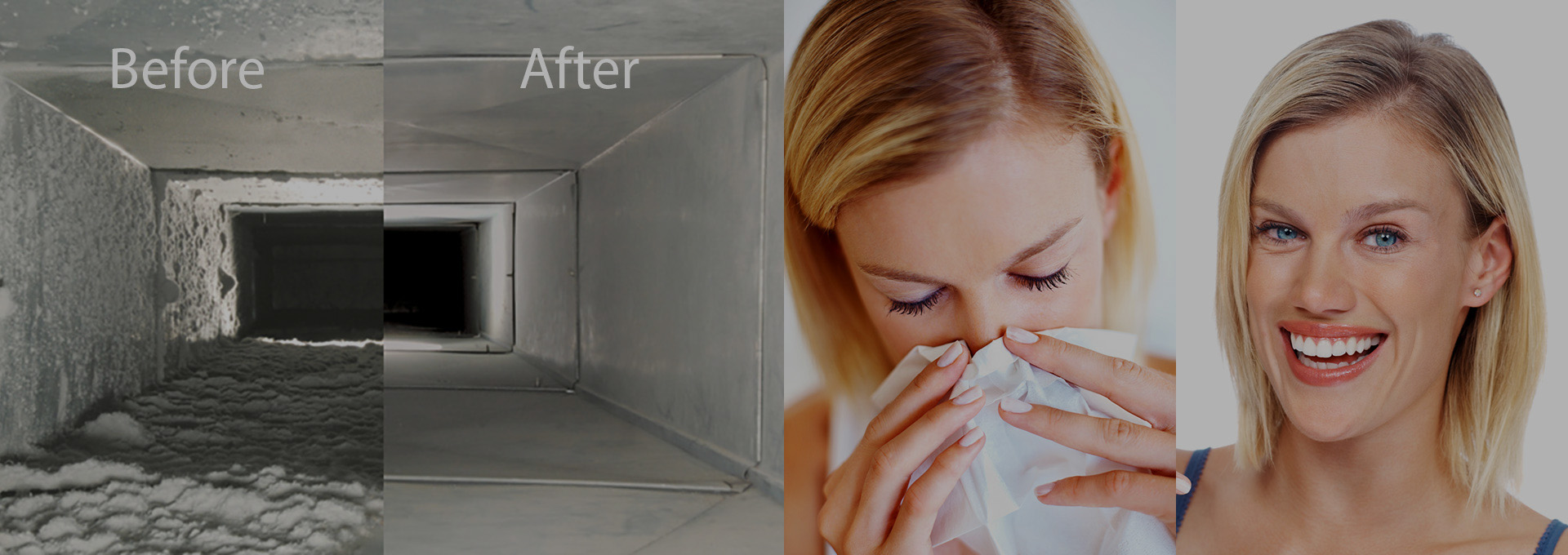Indoor Air Quality- Causes How To Improve

The air quality at home has a big impact on you and your family members’ health. Find out what causes indoor air polalution and how to improve your air’s quality with professional air duct cleaning.
It is worth ensuring that the air quality in your home is as best as possible. The composition of indoor air is different than that of outside air. Some substances that are floating around in bad quality air may be irritating or permanently harmful, also carcinogenic. In a home, poor air quality is caused by tobacco smoke, allergens, bacteria, toxic compounds and chemicals. Indoor air quality is primarily determined by the efficiency of your home’s ventilation and clean air ducts, which can become contaminated with pollutants that are associated with adverse health effects.
Clear Signs You Need Air Duct Cleaning
 The clearly visible symptoms of malfunctioning air ducts and the entire ventilation system are foggy windows with condensed water droplets. This is a clear indication that excess moisture is not being removed from the inside. If you don’t react on time, the walls may become damp, which can cause mold to develop over time, which is difficult to get rid of.
The clearly visible symptoms of malfunctioning air ducts and the entire ventilation system are foggy windows with condensed water droplets. This is a clear indication that excess moisture is not being removed from the inside. If you don’t react on time, the walls may become damp, which can cause mold to develop over time, which is difficult to get rid of.
Another sign that you may need your air ducts cleaned is an unpleasant smell that seems to be hanging in the air. If you smell a musty odor coming from your vents it may be a sign your air duct system is contaminated with large deposits of dust or mold.
A well-functioning and clean air duct system minimizes the risk of excessive air pollution in the house!
What can pollute your indoor air?
There are many sources of indoor air pollution. Most often they are excess of carbon dioxide and water vapor as well as oxygen deficiency resulting from, for example, human and animal respiration (metabolism). The increase of harmful substances can be also caused by cooking, an improperly-working HVAC system, and even by improperly using a fireplace. Combustion produces carbon monoxide and nitrogen oxides. At low concentrations, there are chemicals in the air that are more hazardous to our health (formaldehyde, polycyclic aromatic hydrocarbons) from building materials, furniture, interior furnishings, and cleaning products.
Numerous air pollutants in the home are caused by smoking cigarettes – tobacco smoke contains, among others, carbon monoxide, nicotine, dimethyl nitrosamine, nitrogen oxides, formaldehyde, phenols, hydrogen cyanide, ammonia – a total of over a thousand different, mainly harmful substances.
What indoor air pollutants are harmful?
Carbon dioxide
A concentration of carbon dioxide (CO2) greater than 5000 ppm (the number of molecules of a chemical compound per million particles of a solution) is already harmful (in our atmosphere the CO2 concentration is about 400 ppm). A significant increase of carbon dioxide in the air causes a feeling of shortness of breath, anxiety, increased respiratory rate, headache and dizziness, and finally, perceptual disturbances, excessive sweating and conjunctival hyperaemia. At a concentration above 10%, dyspnea and weakness increase, there are convulsions, hallucinations and disturbances of consciousness, including falling into a coma. A concentration of over 20% causes death within several minutes, and over 30% – immediate death.
Carbon monoxide
Carbon monoxide (CO) limits the ability of hemoglobin to transport oxygen around the body, as a result of which the central nervous system and the circulatory system are primarily damaged. The average CO content in the air is 1000 mg/m3. Smoking in a room may cause a temporary increase of CO in the air to 10,000 mg/m3. A concentration of carbon monoxide in the air of 100-200 ppm, after two or three hours may cause intense headaches, and a concentration above 1600 ppm is life-threatening.
Nitric oxide
At high temperatures (during combustion), nitrogen and oxygen atoms combine and form nitrogen oxides (NOx). So their increased concentration occurs in rooms where cigarettes are smoked or where gas appliances, fireplaces, etc are located. The NOx concentration there can reach up to several thousand mg/m3, while in the atmosphere, in urbanized areas, it’s only several dozen mg/m3. Nitrogen oxides have a detrimental effect on the respiratory tract, they also cause immunological and hematological changes, as well as a reduction in the level of vitamin C in the body.
Formaldehyde
Contact with formaldehyde (HCHO) at a concentration of 120-600 mg/m3 causes stinging and watery eyes and irritation of the upper respiratory tract. When the concentration rises above 12,000 mg/m3, it can cause coughing, shortness of breath, heart palpitations and a feeling of high pressure in the head. For people suffering from asthma, as little as 300 mg/m3 can initiate a serious asthma attack. Formaldehyde is present mainly in furniture boards (chipboards, fibreboards, laminates) as well as in insulating foams and textiles.
Dust
Your indoor air can be also polluted with numerous dust particles that have been floating around for a long time. Household dust can contain mites and their faeces, viruses, bacteria, mold spores, mineral fibers, pesticides, toxins from burning various substances, or heavy metals. The most vulnerable to the harmful effects of these substances are children and the elderly, whose immune and filtering systems (nose, respiratory tract) are not as effective as those of healthy adults. The negative reactions of the body to such pollutants occur not only in allergy sufferers, but also in people who are hypersensitive and have damaged cells and organs (nose, throat, eyes).
 Mold & fungi
Mold & fungi
Microorganisms, such as algae, fungi, protozoa, bacteria, cyanobacteria, cause many negative reactions in humans. Their high concentration in the air at home can cause inflammation of the nasal mucosa, asthma, increased body temperature, chills, muscle pain, dermatitis, allergic alveolitis. The presence of mold spores in the air can do more than just trigger asthma attacks. It can cause very serious, extremely life-threatening fungal inflammations of the respiratory system, including chronic sinusitis, chronic pharyngitis, tonsillitis and recurrent bronchitis and pneumonia.
Ducting Cleaning Will Improve Your Indoor Air Quality
First of all, in order to have clean air at home, you should try to reduce the emission of pollutants. All store-bought chemical products theoretically meet the standards of the ACS, so you should pay attention to whether the building materials and interior fittings you buy have the appropriate certificates.
In addition to regularly cleaning the entire home (vacuuming), it is necessary to take care of your HVAC system and your air ducts, which, if not cleaned, can lead to serious problems like mold or mildew growth. In addition, dirty and clogged air ducts will reduce the quality of your air as they are constantly circulating bacteria and other toxic substances, which can be harmful to health and even fatal.
 For professional air duct cleaning call PT Duct – we’ll have your air ducts working good as new, so you and your family can enjoy clean and fresh air in your home. Contact us at 773-517-5350!
For professional air duct cleaning call PT Duct – we’ll have your air ducts working good as new, so you and your family can enjoy clean and fresh air in your home. Contact us at 773-517-5350!







